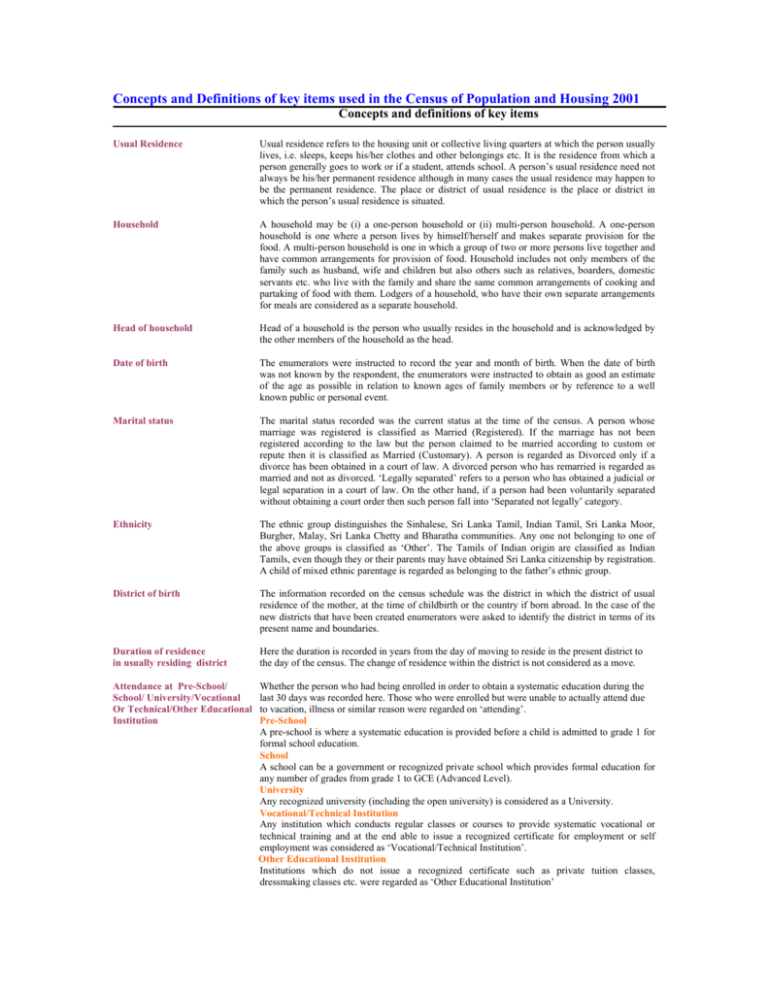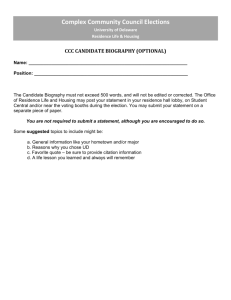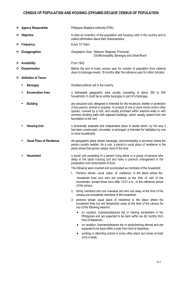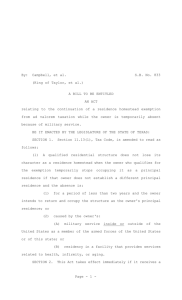Concepts and Definitions - Department of Census and Statistics
advertisement

Concepts and Definitions of key items used in the Census of Population and Housing 2001 Concepts and definitions of key items Usual Residence Usual residence refers to the housing unit or collective living quarters at which the person usually lives, i.e. sleeps, keeps his/her clothes and other belongings etc. It is the residence from which a person generally goes to work or if a student, attends school. A person’s usual residence need not always be his/her permanent residence although in many cases the usual residence may happen to be the permanent residence. The place or district of usual residence is the place or district in which the person’s usual residence is situated. Household A household may be (i) a one-person household or (ii) multi-person household. A one-person household is one where a person lives by himself/herself and makes separate provision for the food. A multi-person household is one in which a group of two or more persons live together and have common arrangements for provision of food. Household includes not only members of the family such as husband, wife and children but also others such as relatives, boarders, domestic servants etc. who live with the family and share the same common arrangements of cooking and partaking of food with them. Lodgers of a household, who have their own separate arrangements for meals are considered as a separate household. Head of household Head of a household is the person who usually resides in the household and is acknowledged by the other members of the household as the head. Date of birth The enumerators were instructed to record the year and month of birth. When the date of birth was not known by the respondent, the enumerators were instructed to obtain as good an estimate of the age as possible in relation to known ages of family members or by reference to a well known public or personal event. Marital status The marital status recorded was the current status at the time of the census. A person whose marriage was registered is classified as Married (Registered). If the marriage has not been registered according to the law but the person claimed to be married according to custom or repute then it is classified as Married (Customary). A person is regarded as Divorced only if a divorce has been obtained in a court of law. A divorced person who has remarried is regarded as married and not as divorced. ‘Legally separated’ refers to a person who has obtained a judicial or legal separation in a court of law. On the other hand, if a person had been voluntarily separated without obtaining a court order then such person fall into ‘Separated not legally’ category. Ethnicity The ethnic group distinguishes the Sinhalese, Sri Lanka Tamil, Indian Tamil, Sri Lanka Moor, Burgher, Malay, Sri Lanka Chetty and Bharatha communities. Any one not belonging to one of the above groups is classified as ‘Other’. The Tamils of Indian origin are classified as Indian Tamils, even though they or their parents may have obtained Sri Lanka citizenship by registration. A child of mixed ethnic parentage is regarded as belonging to the father’s ethnic group. District of birth The information recorded on the census schedule was the district in which the district of usual residence of the mother, at the time of childbirth or the country if born abroad. In the case of the new districts that have been created enumerators were asked to identify the district in terms of its present name and boundaries. Duration of residence in usually residing district Here the duration is recorded in years from the day of moving to reside in the present district to the day of the census. The change of residence within the district is not considered as a move. Attendance at Pre-School/ School/ University/Vocational Or Technical/Other Educational Institution Whether the person who had being enrolled in order to obtain a systematic education during the last 30 days was recorded here. Those who were enrolled but were unable to actually attend due to vacation, illness or similar reason were regarded on ‘attending’. Pre-School A pre-school is where a systematic education is provided before a child is admitted to grade 1 for formal school education. School A school can be a government or recognized private school which provides formal education for any number of grades from grade 1 to GCE (Advanced Level). University Any recognized university (including the open university) is considered as a University. Vocational/Technical Institution Any institution which conducts regular classes or courses to provide systematic vocational or technical training and at the end able to issue a recognized certificate for employment or self employment was considered as ‘Vocational/Technical Institution’. Other Educational Institution Institutions which do not issue a recognized certificate such as private tuition classes, dressmaking classes etc. were regarded as ‘Other Educational Institution’ Educational Attainment This refers to the highest academic qualification obtained. Professional and technical qualifications were excluded. In the case of persons with no such qualifications it is the highest grade or class passed in school. Literacy The census schedule provided for recording the ability to speak and read and write Sinhala, Tamil and English. A person was considered to be able to read and write a language only if he/she could both read with understanding and write a short letter or paragraph in that language. A person who is able to read and write at least one language was regarded as literate. Labour force The labour force is composed of the economically active population aged 10 years and over. Usually economically active population The usually economically active population is defined as those persons who are/were employed or unemployed in major portion of the reference period of last 12 months immediately prior to the census. Twenty six weeks or more is defined as the major portion. Usually employed A person who works for pay, profit or unpaid family gain for major portion of the economically active period is considered to have been employed during the above reference period. Usually unemployed A person who did not work but who was seeking or available for work for major portion of the economically active period is considered to have been unemployed during the above reference period. Usually economically inactive population Persons who are/were neither working nor available/seeking for work during the major portion of reference period of last 12 months immediately prior to the census are considered as usually economically inactive population. Occupation and Industry Information was collected from each employed person regarding his/her occupation and the industry in which he/she worked, and his/her employment status. Occupation Occupation refers to the kind of work done by the person during the reference period. If a person had worked in more than one occupation then the principal occupation was recorded. Occupational classification was based on the latest International Standard Classification of Occupations developed in 1988 (ISCO88), which was approved by the Fourteenth International Conference of Labour Statistics (ICLS). Industry Industry refers to the kind of economic activity carried on in the establishment in which the person works. In the case of self-employed persons it refers to the activity performed by the person. Industry classification was based on the most recent revision viz. Revision 3 of 1990 of the International Standard Industrial Classification of all Economic Activities (ISIC). Employment status The employment status is divided into four major categories. Employee An employee is a person who works for salary, wages, commissions, piece rate or profit. The payment can be made either monthly, weekly or daily or for work performed. Work could be on the basis of permanent, temporary or casual. The payment need not be in cash; it could be in kind or other profits and benefits. Employees are further subdivided into government, semi-government and private sector employees depending on the sector of employment. Employer A person who works in his/her own enterprise, independent profession, trade or who operates his/her own family enterprise engaging one or more paid employees on a regular basis is defined as an employer. Own account worker A person, who is working in his/her own business or practicing a profession or working in family enterprise without engaging paid employees on a regular basis, would be identified as an own account worker. Unpaid family worker (Contributing to family enterprises) A person who is assisting the family economic activity without any payment is identified as an unpaid family worker. Children ever born Information on the number of children borne alive pertains to all ever married females 15 to 49 years of age. The number includes all live-born children during the lifetime of the women up to the census date. Fetal deaths or stillbirths are to be excluded. Children living together in the household, living elsewhere, dead, and total children ever born are to be recorded . Housing Unit The following 3 conditions should be satisfied in order to consider a building unit as a housing unit; (i) It should be a place of dwelling of human beings. (ii) It should be separated from other places of dwelling. (iii) It should have a separate entrance. 2 Under this definition any building or a part of building or any structure whether permanent or temporary such as huts, shanties, sheds etc., which are in fact used as place of residence were regarded as housing units. Collective Living Quarter A place where two or more unrelated persons share common living arrangements is considered as a collective living quarter. Institution This is a special case of collective living quarters, designed to house groups of persons who are bound by either a common public objective or a common personal interest under the supervision of a central authority sharing common living arrangements. E.g. School hostels, Nurses hostels, University hostels, Police and military barracks, Rehabilitation camps, Detention camps, Prisons, Convents, Hospitals, Clergy houses etc. Non-housing Unit Every building or part of a building which is not used as a place of dwelling is a non housing unit. e.g.: office, petrol filling station, shop etc. Room A room is a space in a house enclosed by walls reaching from the floor to the ceiling or roof, at least to a height, just above the height of an average person, and of a size large enough to hold an average size bed. In determining the number of rooms in the housing unit all rooms used for living purposes such as living rooms, bed rooms, dining rooms, office rooms, servants’ rooms, kitchen/Pantries were included but store rooms, bath rooms, toilets, garages and verandas were excluded. Type of Housing Unit The classification was made on the basis of the principal materials used in the construction of the wall, roof and floor. In general, where the materials used were of the durable type like bricks, cement, tile, asbestos sheets etc. the units were classified as permanent. Where the walls and roof were made of cadjan, palmyrah or other inferior or non-durable material the units have been classified as improvised. Where a mixture of durable and non-durable materials have been used the units have been generally classified as semi-permanent. The following table shows the detailed scheme of classification. Basis of classification of housing units into permanent, semi-permanent and improvised types Type of housing unit Type of principal material of unit Wall Permanent Semi-permanent Improvised Type of Structure Roof Floor Brick/Cabook/Cement blocks/ Stone/Pressed soil blocks Tile/Asbestos/Concrete/ Metal sheets Cement/Terrazzo/Tile Granite/Wood Mud Tile/Asbestos/Metal sheets Cement Brick/Cabook/Cement blocks/ Stone/Pressed soil blocks Tile/Asbestos/Metal sheets Mud Brick/Cabook/Cement blocks/ Stone/Pressed soil blocks Cadjan/Palmyrah/Straw/ Metal sheets Cement/Mud/Wood Mud Tile/Asbestos/Metal sheets Mud/Wood Mud Cadjan/Palmyrah/Straw Cement/Mud/Wood Plank/Metal sheets Tile/Asbestos/Metal sheets Cement/Mud/Wood Plank/Metal sheets Cadjan/Palmyrah/Straw Cement Cadjan/Palmyrah/Straw Any material Any material Plank/Metal sheets Cadjan/Palmyrah/Straw Mud/Wood/Sand Single house A single house stands by itself and is not attached to another unit as in a twin house, flats etc. Units constructed of interior materials such as cadjan, discarded wooden planks etc. not be classified into this category. 3 Attached house/Annex If there are two or more housing units constructed as one building, each housing unit could be considered as an attached house/annex. If a building is separated into two or more housing units and if two housing units are constructed attached to one another as a one building (twin houses) then each housing unit would be considered as an attached house/annex. In housing schemes, where housing units are attached to one another (either in twos or even more) would be considered as an attached house/annex. Flats are not considered here. If there is a housing unit is a part of a building and adjoining part is occupied by a business premises then the housing unit is an attached house/annex. Flat This category consist of all flats and apartments. The structure of each unit is considered as a flat. Row house/Line room Row houses are situated adjoining to one another in a row and usually constructed with a similar pattern. Line rooms refer to the type of labourers accommodation found in estates as well as similar units in other areas, and all houses found in a row adjoining each other. Hut/Shanty This refers to the poorest type of houses generally constructed of inferior or waste materials, e.g., Shanties in urban areas and small units constructed of cadjan, palmyrah or straw, discarded wooden planks or metal sheets, etc. Occupants All usual resident population in the unit as considered as occupants. Protected Well A protected well has a wall round the well preventing any drained water from outside flowing into the well. Tap Water (Main line) Purified drinking water which is supplied by the Local Government Authority or the Water Resources Board is considered as tap water (main line). This is classified into tap within or outside unit depending whether the source is available within or outside the unit. 4









